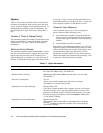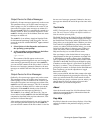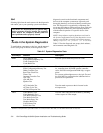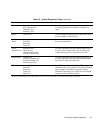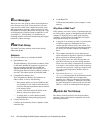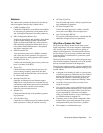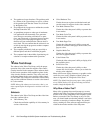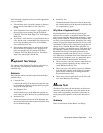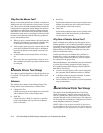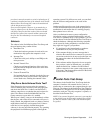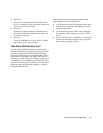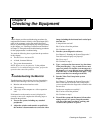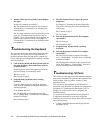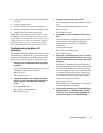
5-14 Dell PowerEdge 6100/200 System Installation and Troubleshooting Guide
Why Run the Mouse Test?
Mouse or touch pad problems are as likely to originate in
RAM as they are to be caused by a faulty mouse or touch
pad. Three sources of RAM-related problems include the
configuration of a program (which changes the function
of the mouse or touch pad), memory-resident programs,
and failure of a device driver (the software that controls
the function of the mouse or touch pad). If these possibil-
ities have been eliminated and the following symptoms
persist, run the Mouse Test:
•
When you press a mouse button or the touch pad, the
function of the button (or touch pad) continues; that
is, the button (or touch pad) seems to be stuck.
•
If the response when you press a mouse button or the
touch pad is different from the usual or anticipated
response, the button (or touch pad) contact may be
damaged.
•
A mouse button or the touch pad does not work at
all.
•
The cursor does not respond on the screen in accor-
dance with the movements you make with the mouse
or touch pad.
D
iskette Drives Test Group
The subtests in the Diskette Drives Test Group allow you
to test both 5.25-inch and 3.5-inch diskette drives of all
capacities.
Subtests
The diskette drive subtests in the Diskette Drives Test
Group and the drive functions they confirm follow:
•
Change Line Test
Checks for bent pins on the diskette drive controller
and for defective lines on the diskette cable.
•
Seek Test
Checks the drive’s ability to search for a specified
track on the diskette and to position its read/write
heads to all tracks.
•
Read Test
Positions the read/write heads at each cylinder of the
diskette for reading data and verifies that all tracks
on the diskette can be read correctly.
•
Write Test
Positions the read/write heads at each cylinder of the
diskette and verifies that all tracks on the diskette
can be written to correctly.
Why Run a Diskette Drives Test?
Often, a diskette drive problem may first appear to be a
diskette problem. A box of defective diskettes might pro-
duce faulty-drive error messages. The test results can be
confusing, so Dell suggests running the subtests in the
Diskette Drives Test Group more than once using dis-
kettes from different sources.
Another possible cause of diskette drive problems is
human error—typing a command in an incorrect form
(usually called a syntax error). Be sure you have entered
the command in the proper form.
When the diskette(s) and command syntax are eliminated
as causes, the following symptoms usually suggest a
drive problem and warrant running a subtest in the Dis-
kette Drives Test Group:
•
An error message appears on the screen stating that
the computer cannot read from or write to a diskette.
•
A diskette cannot be properly formatted, or format
error messages appear on the screen.
•
Data on diskettes is corrupted or lost; these problems
may be intermittent.
S
erial/Infrared Ports Test Group
The subtests in the Serial/Infrared Ports Test Group
check the computer’s interface with external devices,
such as a printer and a mouse, that are connected to the
computer through a serial or infrared port. The subtests in
this test group are not intended as a diagnostic test for the
actual peripheral attached to each port.
NOTES: With certain modems installed, the subtests in
the Serial/Infrared Ports Test Group may fail because the
modem appears to the diagnostics as a serial or infrared



